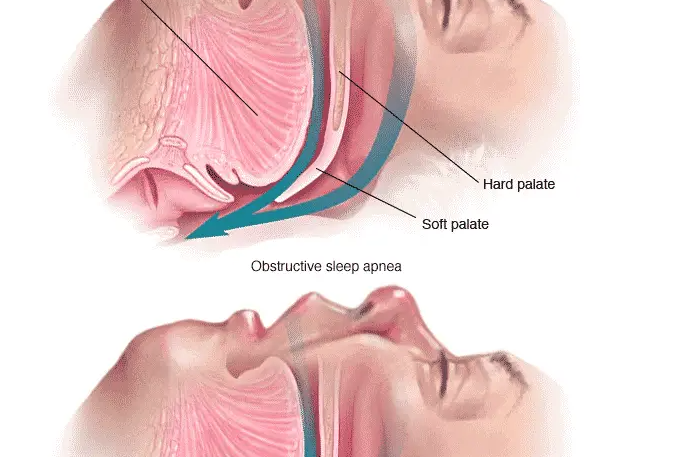Understanding Sleep Apnea

What is sleep apnea?
Sleep apnea is a condition characterized by involuntary interruption of breathing during sleep. This interruption occurs for brief periods. During normal breathing, air flows smoothly into the lungs. In sleep apnea, this smooth flow of air is interrupted repeatedly throughout the night. This interruption is due to the narrowness of the airway space in the throat region. Snoring is a major symptom of sleep apnea. Snoring occurs when air squeezes through the narrow air space. Leaving your sleep apnea untreated, especially in severe cases, can result in serious exacerbations of conditions, including:
- Heart disease
- Hypertension
- Diabetes
- Myocardial infarction
- Stroke
- Aggravated obesity
The best way to prevent complications is by getting the right diagnosis and treatment in a timely manner from Board-Certified Sleep Specialists, such as the physicians at Potomac ENT.
What are the symptoms of sleep apnea?
If sleep apnea shortens or decreases the oxygen supply to your brain, your quality of sleep will be poor, resulting in daytime drowsiness. Common symptoms of sleep apnea include:
- Loud snoring
- Persistent headaches
- Forgetfulness
- A grumpy or disgruntled feeling
- Drowsiness
Other symptoms of sleep apnea include:
- Depression
- Hyperactivity and ADHD (especially in kids)
- Fatigue and lethargy (especially in adults)
- Low libido
- Swelling of the leg (edema) in severe cases
Daytime drowsiness increases your risk for automobile or industrial accidents, but with proper treatment, you can be relieved of daytime drowsiness.
What are the types and causes of sleep apnea?
There are three types of sleep apnea:
- Obstructive sleep apnea: It is the most common. In obstructive sleep apnea, the airway is floppy, blocked, or narrowed. It generally occurs in the elderly and also in overweight people. Studies have shown that weight loss results in a significant improvement in sleep apnea symptoms.
- Central sleep apnea: The airway is free. It isn’t blocked as in obstructive sleep apnea. However, the brain fails to send signals to the respiratory muscles, and so breathing becomes distorted.
- Mixed sleep apnea: This is a combination of central sleep apnea and obstructive sleep apnea.
What are the risk factors for sleep apnea?
You have a high risk for sleep apnea if your upper respiratory tract is narrow. Other factors that constitute a risk include:
- Having large adenoids or tonsils
- Having a large tongue (this can block the air passageway)
- Having a narrow airway or palate (it collapses easily)
- Retrognathia (your upper jaw is longer than your lower jaw).
- Men who have a collar size greater than 17 inches
- Women who have a collar size greater than 16 inches
Diagnosing obstructive sleep apnea
Your healthcare provider will get your complete medical history, and also perform a physical examination. He or she will watch out for cues such as a history of snoring and daytime drowsiness. Your head and neck will be examined to identify physical factors that may be associated with sleep apnea. You may also be asked to respond to a questionnaire about your sleep habits, daytime drowsiness, and quality of sleep.
Your healthcare provider may also perform some tests, including:
- Nocturnal polysomnography
- Home sleep study test
- Arterial blood gas analysis
- Pulse oximetry test
- Electrocardiogram
- Electromyogram
- Electrooculogram
- Electroencephalogram
Treatment for sleep apnea
Treatment aims to ensure the free flow of air through your airway. Treatment will ensure that your airflow is not obstructed during sleep.
Common treatments for sleep apnea include:
- Weight loss
- Continuous positive airway pressure (CPAP) therapy
- Nasal decongestants
- Positional therapy
- Surgical procedures such as uvulopalatopharyngoplasty (UPP) or tracheostomy
Apnea prevention
To reduce your risk of developing the disease, these guidelines may help:
- Do not drink alcohol in the evening, and stop using sedatives that reduce muscle tone.
- Try to quit smoking. At the very least, don’t smoke right before bed.
- Increase your physical activity to combat obesity and adjust your diet by eliminating foods that contribute to obesity.
Prognosis
Please consult a healthcare provider, such as the physicians at Potomac ENT, if you have a history of daytime drowsiness or persistent sleep problems. Sleep apnea can be treated. Your healthcare provider will create a plan of treatment that is most suitable for you – one that combines lifestyle modifications with other therapies.
Subjects
Tags
Allergy Apnea Asthma balloon sinuplasty bronchitis CAdENT Chronic Congestion Deviated Septum Doctor Ear Nose Throat Ear Ringing ENT ent doctor ENT Doctor ent surgery Headaches Hearing Test Infection Laryngoscopy larynx Nasal Nasal Valve Collapse Nosebleed Potomac ENT Rhinosinusitis Sinus Sinusitis Sleep Sleep Apnea Snoring Surgery Therapy Throat Tinnitus TMJPeople Say
Great experience. They are courteous and knowledgeable.
Lisa Berry
Patient
Northern VA Office
14000 Crown Ct
Suite 201
Woodbridge, VA 22193
Call: (703) 499-8787
Northern VA Office
385 Garrisonville Rd
Ste. 208-209
Stafford, VA 22554
Call: (703) 499-8787
Northern VA Office
14000 Crown Ct
Suite 201
Woodbridge, VA 22193
Call: (703) 499-8787
Northern VA Office
385 Garrisonville Rd
Ste. 208-209
Stafford, VA 22554
Call: (703) 499-8787
© Copyright 2023 Potomac Otolaryngology, The Centers For Advanced ENT Care, LLC. All rights reserved. Empowered with arPlatform + arTeam.
© © Copyright 2023 Potomac Otolaryngology, The Centers For Advanced ENT Care, LLC. All rights reserved.
Empowered with arPlatform + arTeam.
